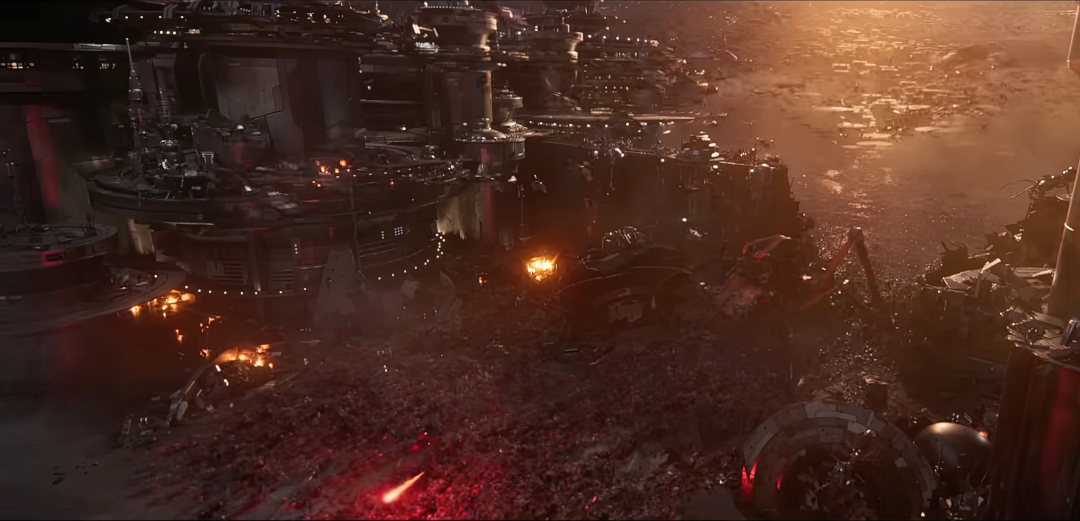Ants, quantumnauts, and Massive
Behind the scenes with Sony Pictures Imageworks and their crowd simulations for 'Ant–Man and the Wasp: Quantumania'.
Just when it looks like the evil Kang (Jonathan Majors) is about to conquer the heroes Scott Lang (Paul Rudd), Hope van Dyne (Evangeline Lilly) and Cassie Lang (Kathryn Newton) in Peyton Reed's Ant–Man and the Wasp: Quantumania, a huge cavalry of advanced ants arrives to save the day.
To help bring those hordes of what were both terrestrial and flying ants to life–as well as a number of shots of bipedal Kang–loyal quantumnaut soldiers – production visual effects supervisor Jesse James Chisholm tapped Sony Pictures Imageworks for several of the battle scenes.
The visual effects studio relied on Massive for its crowd work in those sequences, reaching up to 26,000 terrestrial and flying ants in a single shot, and up to 9,000 quantumnauts. The terrain features of Massive 9, and the lane place feature, which allow for simultaneous placement of lanes and agents, were just two of the tools inside Massive that Imageworks looked to for populating both sky and ground.
"The final cut of our sequence required 25 quantumanut and seven ant crowd shots done in Massive," details Imageworks visual effects lead crowd TD Kevin Kitchel. "Massive was also used for a couple of shots with a large number of flying ships. The shots were fully CG with hero animation done for any main characters or specific foreground actions with Massive simulation filling the rest of the scene. This usually involved importing the completed heroes as standin agents to be avoided or targeted."
Ant Agents
There would be eight different ant species required for the crowds, each with a unique model and rig created by Imageworks' asset artists. To begin the agent set up process in Massive, animation clips and rigs were exported by Maya along with skincluster weights for the geometry.
"Then," says Kitchel, "the animation team created a fast and slow run cycle for each ant plus one flying clip for the winged ant. Additional procedural animation was performed in Massive to make leg and body adjustments for turning, terrain adaptation, speed changes and secondary motion while flying."
Further agent brain development in Massive provided the ants with controls for adhering to and navigating complicated 3D terrain. Imageworks was also asked to add armor and mechanized 'tech' costume pieces to the ants. "For that, another round of crowd rigging was fast tracked as we entered shot work," states Kitchel. "Agent geometry selection was done in Massive and material variations were applied in Katana by our lookdev team."

© 2023 Marvel Studios
Directing performance
It was decided that the ants featured in the attack scene needed to, while swarming towards Kang, exhibit specific actions that were a directable reproduction of realistic ant colony behaviors. Kitchel says "this included branching streams of ants, piling and crawling over each other, bridging gaps, orientation agnostic pathfinding, and flying for the winged ants."
A technique of selective avoidance was developed in Massive so that ants of greatly varying sizes could move through the scene together, at times spreading out to follow proximity limits and allowing clustering and crawling over where necessary through constricted areas.
Meanwhile, the bipedal quantumnaut army members were seen populating the main Kang base pre–battle, often marching in formation or moving as regimented groups, or sometimes needing to rush into position.
"They were built with targeting and firing capabilities so they could shoot spawned laser blast agents during battle," explains Kitchel. "They mostly needed to flee and avoid the feet of a rampaging giant Scott Lang as Ant–Man as they retreated through the demolished structures of the city. Dynamics and cloth were set up in Massive for simulated motion on the leather flaps of their suits and to enable Bullet dynamics solver–driven deaths as they were trampled by ants."
Breaking down a scene
One of the first ant crowd shots of Imageworks' seen in the film was also the largest by number and type of agents involved – 26,000 terrestrial and flying ants. The shot displays the magnitude of the advancing ant army overtaking the city and has ants streaming over all surfaces, swarming through the sky, and rushing as an unstoppable wave through the resisting quantumnauts.
Kitchel advises that "it was important to apply the ant development at scale to get client buyoff on the look and behavior of the crowd and to understand any challenges in our pipeline." Since there were several large hero ants and foreground quantumnauts animated by character animators, Kitchel broke the crowd into seven separate Massive scenes, as he explains further.
"This was to help facilitate iterations on the areas receiving the most notes. I then used Houdini to prepare and export obj meshes for the terrain and also to generate apf files for Massive simulation input to partition the crowd and set agent starting position and orientation."
Taking advantage of new tools
Kitchel calls out the terrain features of Massive 9 as crucial to creating an agent that can traverse any surface in three dimensions and where the crowd itself becomes the surface. "With the agents–as–terrain feature and the addition of segments to ground color sampling," he says, "I was able to customize adaptation rules to control the behavior of the ants as they swarmed over each other through complicated environment geometry."
Another bonus came in the form of the improved dynamic terrain parenting inside Massive, notes Kitchel. "It was also useful in one shot where the ants attack and pull down a ship attempting to take off."
"Finally, the lane place tool was much appreciated while populating the skies of several shots with 4000 flying ants!"


